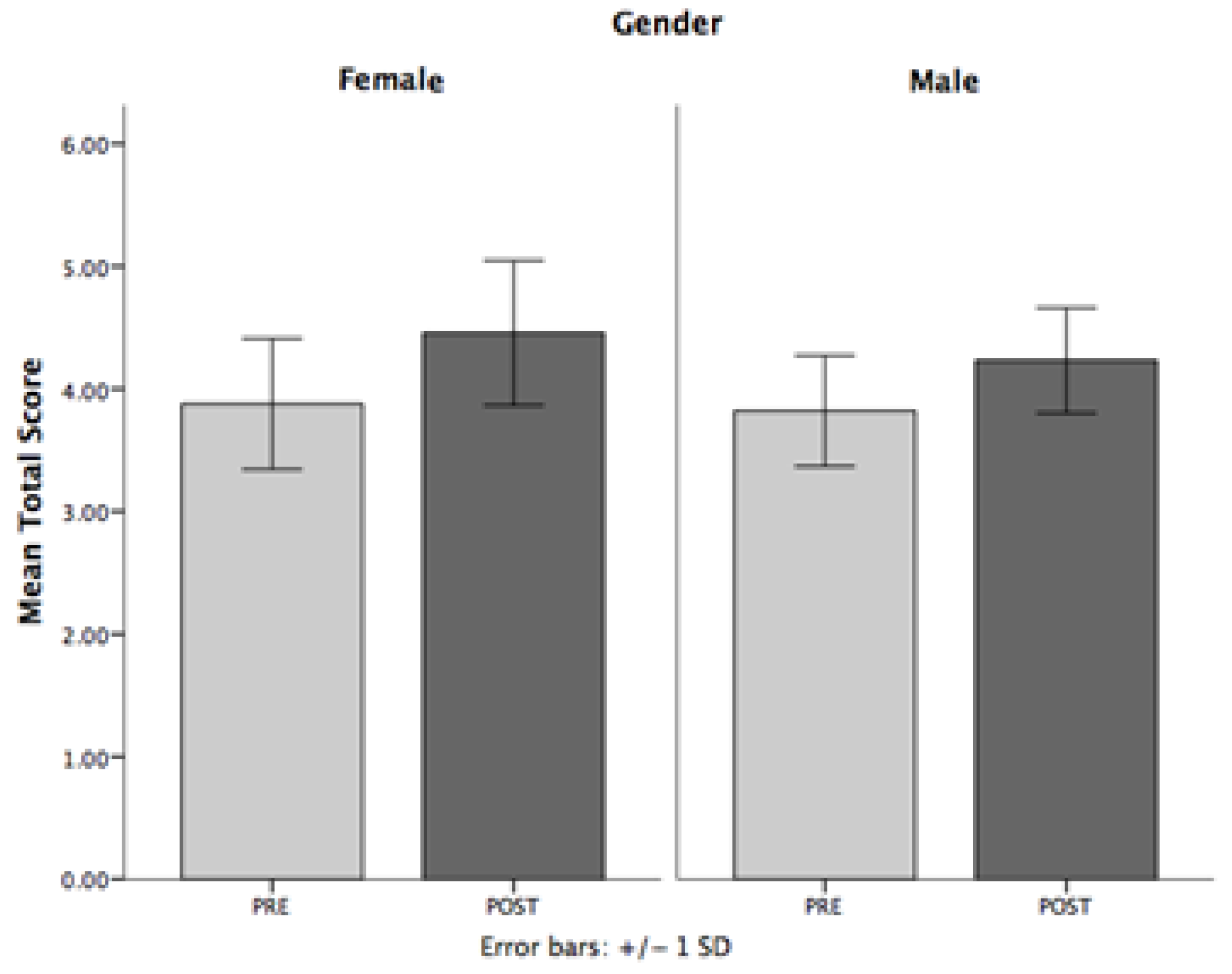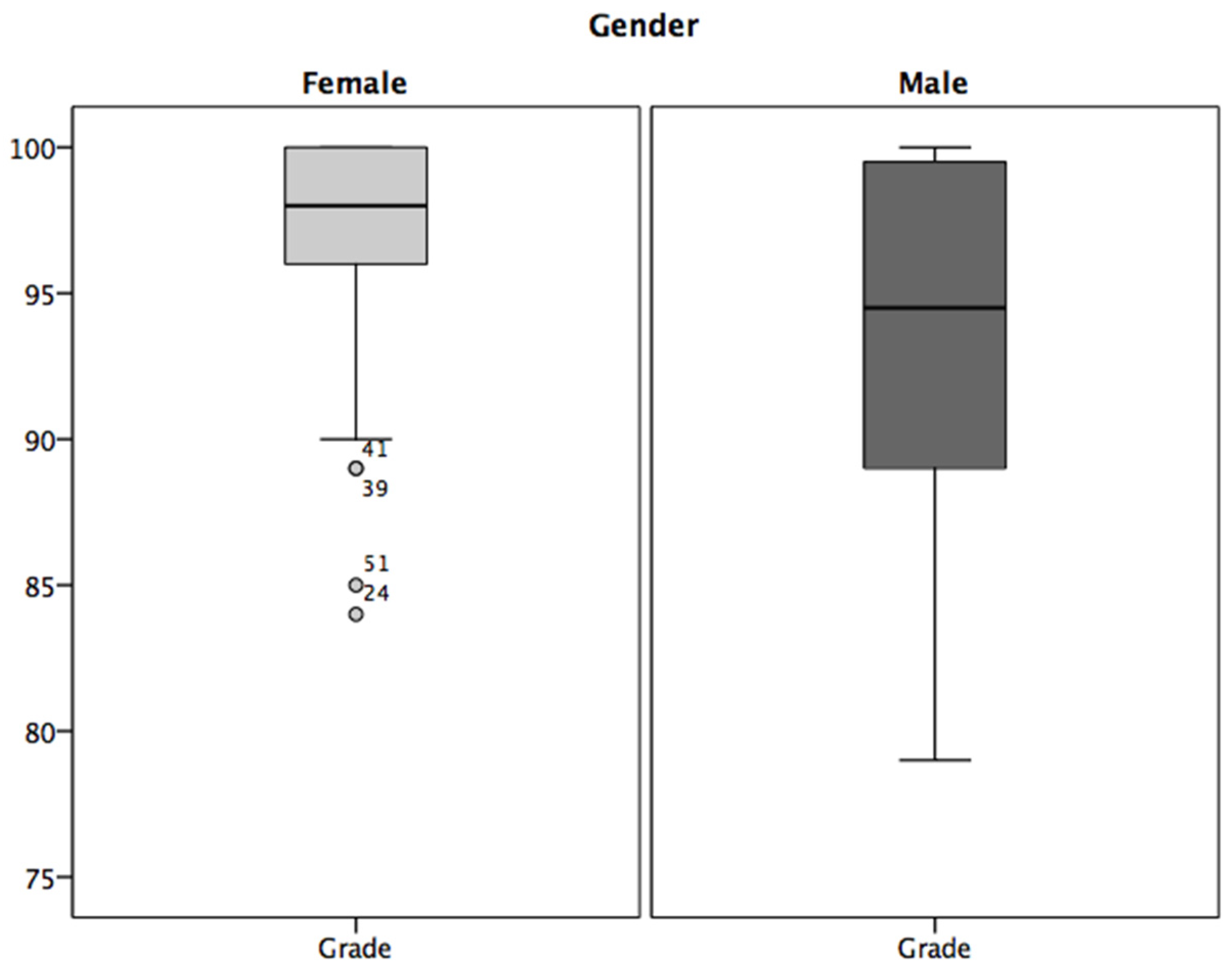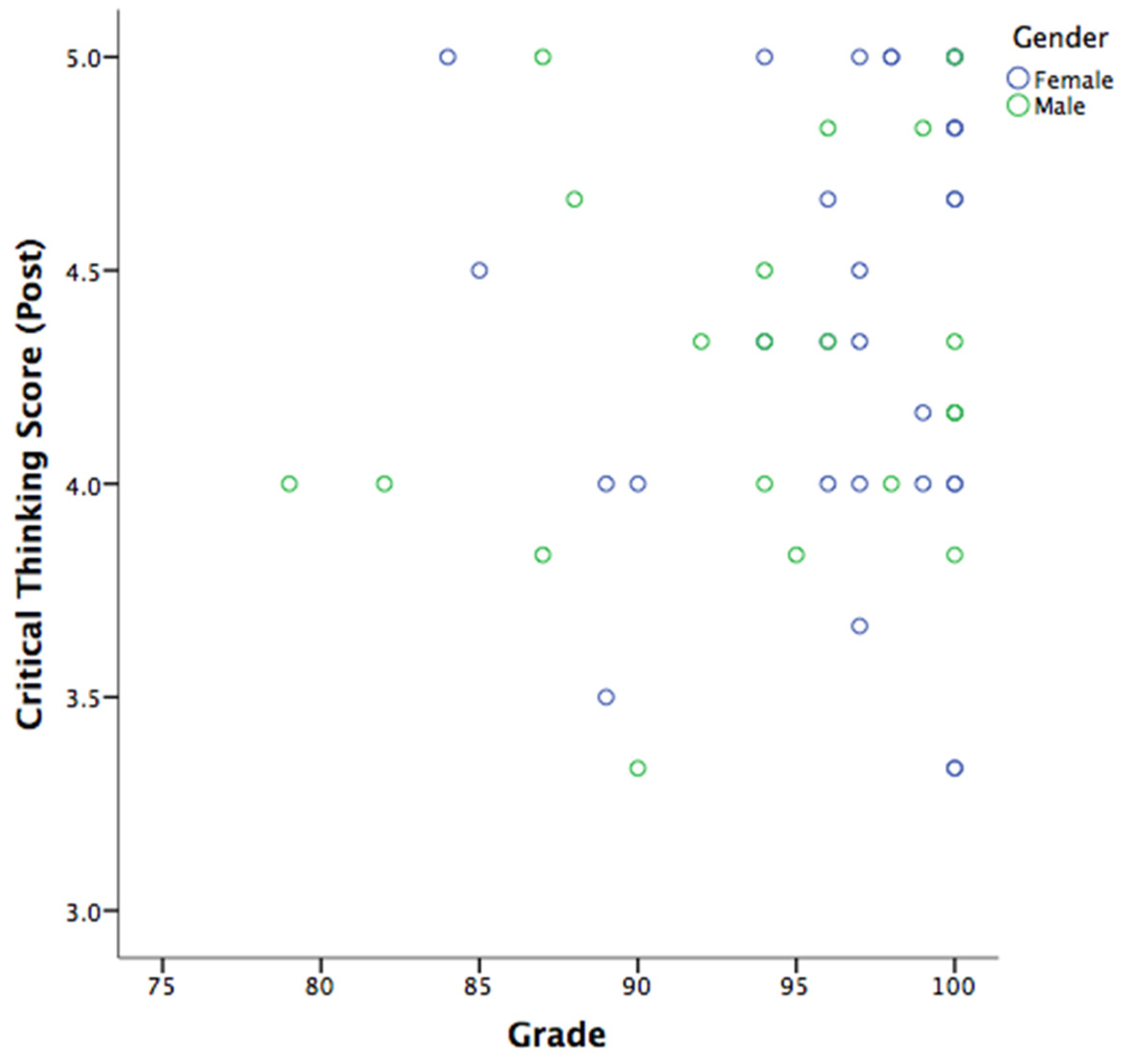Critical Thinking and Student Well-Being: An Approach in University Students
Abstract
:1. Introduction
1.1. Theoretical Framework
The Promotion of Human Wellness by Universities
1.2. Competencies and Skills Associated with Human Well-Being
1.3. Complex Thinking and Its Impact on Human Well-Being
1.4. Critical Thinking as a Relevant Cognitive Skill for Well-Being
2. Materials and Methods
2.1. Participants and Procedure
2.2. Instrument and Data Analysis
3. Results
4. Discussion
- The participants of the studied course improved their perceived achievement of complex thinking competency and all its subcompetencies. This is in accordance with previous studies such as those conducted by Cruz-Sandoval, Vázquez-Parra, and Amézquita-Zamora [21], who found that there is a natural development of the complex thinking competence in students, although in their study, they do not specify a specific course;
- Although the critical thinking subcompetency did not improve the most, it did have the highest means in both the women’s and men’s groups. The best improvement occurred in the scientific thinking subcompetency. This is consistent with that identified by Cruz-Sandoval et al. [45], who applied a similar study in a group of engineering students and found a similar trend in which, although scientific thinking was not the subcompetency with the highest mean, it was the one that showed the highest development within a formative process;
- Despite the numerical improvement, the men’s improvement in the critical thinking subcompetency from the beginning to the end of the course was not statistically significant, but the female improvement was. This tendency to show a better perception on the part of women had also already been identified by Vázquez-Parra et al. [27] who applied EComplexity to a group of higher education students and found that women not only showed the best averages but also showed the most favorable development;
- Regarding final grades, females had the highest mean;
- Although a slight correlation can be seen between the perceived achievement of the critical thinking subcompetency and the participants’ grades, this relationship cannot be proven statistically significant, remaining only as a possible association. In this sense, it is not possible to argue that the level of engagement and analysis performed in their class assignments could be directly influenced by their level of critical thinking.
Academic Limitations and Implications
5. Conclusions
Author Contributions
Funding
Institutional Review Board Statement
Informed Consent Statement
Data Availability Statement
Acknowledgments
Conflicts of Interest
References
- Eaton, S.; Pethrick, H.; Turner, K. Academic Integrity and Student Mental Wellbeing: A Rapid Review. CPAI 2023, 5, 34–58. [Google Scholar] [CrossRef]
- Van den Borgerd, N.; Dijkstra, C.; Koole, S.; Seidell, J.; de Vries, R.; Maas, J. Nature in the indoor and outdoor study environment and secondary and tertiary education students’ wellbeing, academic outcomes, and possible mediating pathways: A systematic review with recommendations for science and practice. Health Place 2020, 66, 102403. [Google Scholar] [CrossRef]
- Lua, V.; Chua, T.; Chia, M.A. Narrative Review of Screen Time and Wellbeing among Adolescents before and during the COVID-19 Pandemic: Implications for the Future. Sports 2023, 11, 38. [Google Scholar] [CrossRef] [PubMed]
- Lyons, Z.; Wilcox, H.; Leung, L.; Dearsley, O. COVID-19 and the mental wellbeing of Australian medical students: Impact, concerns and coping strategies used. Australas. Psychiatry 2020, 28, 649–653. [Google Scholar] [CrossRef]
- ILO. Youth and COVID-19. Impacts on Jobs, Education, Rights and Mental Well-Being. Survey Report 2020. International Labour Organization, 2020, ISBN: 9789220328606. Available online: https://www.ilo.org/wcmsp5/groups/public/---ed_emp/documents/publication/wcms_753026.pdf (accessed on 8 August 2023).
- Ramos, L.; Meador, A. College students’ grit, autonomous learning, and wellbeing: Self-control as a mediator. Psychol. Sch. 2022, 60, 53–77. [Google Scholar] [CrossRef]
- Hoffman, K.; Elwin, C. The relationship between critical thinking and confidence in decision making. Aust. J. Adv. Nurs. 2004, 22, 8–12. Available online: https://search.informit.org/doi/10.3316/ielapa.404658904618484 (accessed on 6 August 2023).
- Cohen, M.S.; Freeman, J.T.; Thompson, B. Critical thinking skills in tactical decision making: A model and a training strategy. In Making Decisions under Stress: Implications for Individual and Team Training; Cannon-Bowers, J.A., Salas, E., Eds.; American Psychological Association: Washington, DC, USA, 1998; pp. 155–189. [Google Scholar] [CrossRef]
- Morales, F.; Espigares, I.; Brown, T.; Pérez, J. The Relationship between Psychological Wellbeing and Psychosocial Factors in University Students. Int. J. Environ. Res. Public Health 2020, 17, 4778. [Google Scholar] [CrossRef]
- Schlesselman, L.; Cain, J.; DiVall, M. Improving and Restoring the Wellbeing and Resilience of Pharmacy Students during a Pandemic. Am. J. Pharm. Educ. 2020, 84, 677–682. [Google Scholar] [CrossRef]
- Tan, Y.; Huang, C.; Geng, Y.; Cheung, S.; Zhang, S. Psychological Wellbeing in Chinese College Students During the COVID-19 Pandemic: Roles of Resilience and Environmental Stress. Front. Psychol. 2021, 12, 671553. [Google Scholar] [CrossRef]
- Visser, M.; Law-van Wyk, E. University students’ mental health and emotional wellbeing during the COVID-19 pandemic and ensuing lockdown. S. Afr. J. Psychol. 2021, 51, 229–243. [Google Scholar] [CrossRef]
- Muyan, M.; Demir, A. A Pathway Towards Subjective Wellbeing for Turkish University Students: The Roles of Dispositional Hope, Cognitive Flexibility, and Coping Strategies. J. Happiness Stud. 2020, 21, 1945–1963. [Google Scholar] [CrossRef]
- Guerra, J.; León, B.; Yuste, R.; López, V.; Mendo, S. Emotional Intelligence and Psychological Wellbeing in Adolescents. Int. J. Environ. Res. Public Health 2019, 16, 1720. [Google Scholar] [CrossRef]
- Yildirim, M.; Celik, F. Social Support, Resilience and Subjective Wellbeing in College Students. J. Posit. Sch. Psychol. 2021, 5, 127–135. [Google Scholar] [CrossRef]
- Alkhatib, M. Investigate the Relationship between Psychological Wellbeing, Self-Efficacy, and Positive Thinking at Prince Sattam Bin Abdulaziz University. Int. J. High. Educ. 2020, 9, 138–152. [Google Scholar] [CrossRef]
- Tse, D.; Nakamura, J.; Csikszentmihalyi, M. Living well by “flowing” well: The indirect effect of autotelic personality on wellbeing through flow experience. J. Posit. Psychol. 2021, 16, 310–321. [Google Scholar] [CrossRef]
- Adams, Q. “No Amount of Baths Is Gonna Make You Feel Better:” Seeking Balance, Wholeness, and Wellbeing in Everyday Self-Care. JUE 2019, 9, 19–32. [Google Scholar] [CrossRef]
- Puscas, L.; Kogan, J.; Holmboe, E. Assessing Interpersonal and Communication Skills. J. Grad. Med. Educ. 2021, 13, 91–95. [Google Scholar] [CrossRef]
- Davis, S.; Hadwin, A. Exploring Differences in Psychological Wellbeing and Self-Regulated Learning in University Student Success. FLR 2021, 9, 30–43. [Google Scholar] [CrossRef]
- Cruz-Sandoval, M.; Vázquez-Parra, J.; Amézquita-Zamora, J. Student perception of the level of development of complex thinking. An approach in university women in Mexico. Edu. Sci. 2022, 1–13. [Google Scholar] [CrossRef]
- Silva, C.; Iturra, C. A conceptual proposal and operational definitions of the cognitive processes of complex thinking. Think. Ski. Creat. 2021, 39, 100794. [Google Scholar] [CrossRef]
- Morin, E. Introducción al Pensamiento Complejo; Gedisa: Ciudad de México, Mexico, 1990. [Google Scholar]
- Jaaron, A.; Backhouse, C. Operationalisation of service innovation: A systems thinking approach. Serv. Ind. J. 2018, 38, 561–583. [Google Scholar] [CrossRef]
- Cui, L.; Zhu, Y.; Qu, J.; Tie, L.; Wang, Z.; Qu, B. Psychometric properties of the critical thinking disposition assessment test amongst medical students in China: A cross-sectional study. BMC Med. Educ. 2021, 21, 1–8. [Google Scholar] [CrossRef]
- Suryansyah, A.; Kastolani, W.; Somantri, L. Scientific thinking skills in solving global warming problems. IOP Conf. Ser. Earth Environ. Sci. 2021, 683, 012025. [Google Scholar] [CrossRef]
- Vázquez-Parra, J.; Castillo-Martínez, I.; Ramírez-Montoya, M.; Millán, A. Development of the Perception of Achievement of Complex Thinking: A Disciplinary Approach in a Latin American Student Population. Educ. Sci. 2022, 12, 289. [Google Scholar] [CrossRef]
- Vázquez-Parra, J.C.; Carlos-Arroyo, M.; Cruz-Sandoval, M.A. Social Entrepreneurship and Complex Thinking: Validation of SEL4C Methodology for Scaling the Perception of Achieved Competency. Educ. Sci. 2023, 13, 186. [Google Scholar] [CrossRef]
- Brown, S.A. Patterning Approach to Complexity Thinking and Understanding for Students: A Case Study. NEJCS 2019, 1, 6. [Google Scholar] [CrossRef]
- Drucker, J. Sustainability and complexity: Knowledge and authority in the digital humanities. Digit. Scholarsh. Humanit. 2021, 26, 86–94. [Google Scholar] [CrossRef]
- Lewis, A.; Smith, D. Defining higher order thinking. Theory Into Pract. 1993, 32, 131–137. [Google Scholar] [CrossRef]
- Sternberg, R.J. Critical Thinking: Its Nature, Measurement, and Improvement National Institute of Education. 1986. Available online: http://eric.ed.gov/PDFS/ED272882.pdf (accessed on 8 August 2023).
- Bailin, S. Critical thinking and science education. Sci. Educ. 2002, 11, 361–375. [Google Scholar] [CrossRef]
- Facione, P.A. Critical Thinking: A Statement of Expert Consensus for Purposes of Educational Assessment and Instruction; The California Academic Press: Millbrae, CA, USA, 1990. [Google Scholar]
- Lipman, M. Critical thinking—What can it be? Educ. Leadersh. 1988, 46, 38–43. [Google Scholar]
- Halpern, D.F. Assessing the effectiveness of critical thinking instruction. J. Gen. Educ. 2001, 50, 270–286. [Google Scholar] [CrossRef]
- Willingham, D.T. Critical thinking: Why is it so hard to teach? Am. Educ. 2007, 109, 8–19. [Google Scholar] [CrossRef]
- Ramírez, M.; Alvarez, I.; Sanabria, J.; López, E.; Alonso, P.; Miranda, J. Scaling Complex Thinking for Everyone: A Conceptual and Methodological Framework. In Proceedings of the Technological Ecosystems for Enhancing Multiculturality TEEM21, Barcelona, Spain, 26–29 October 2021; pp. 806–811. [Google Scholar] [CrossRef]
- Tobón, S.; Luna, J. Complex Thinking and Sustainable Social Development: Validity and Reliability of the COMPLEX-21 Scale. Sustainability 2021, 13, 6591. [Google Scholar] [CrossRef]
- Luna, J.; Tobón, S.; Juárez, L. Sustainability-based on socio-formation and complex thought or sustainable social development. Resour. Environ. Sustain. 2020, 2, 100007. [Google Scholar] [CrossRef]
- Ollinheimo, A.; Hakkarainen, K. Critical thinking as cooperation and its relation to mental health and social welfare. New Ideas Psychol. 2023, 68, 100988. [Google Scholar] [CrossRef]
- Tecnologico de Monterrey. Razonamiento Para la Complejidad. En Tecnologico de Monterrey, Competencias Transversales. Una Visión Desde el Modelo Educativo Tec21; Tecnologico de Monterrey: Monterrey, Mexico, 2019; pp. 62–76. [Google Scholar]
- Castillo-Martínez, I.; Ramírez-Montoya, M.; Torres-Delgado, G. Reasoning for complexity competency instrument (e-Complexity): Content validation and expert judgment. Assess. Eval. High. Educ. 2022, (in press). [Google Scholar]
- Williamson, D.F. The Box Plot: A Simple Visual Method to Interpret Data. Ann. Intern. Med. 1989, 110, 916. [Google Scholar] [CrossRef]
- Cruz-Sandoval, M.; Vázquez-Parra, J.C.; Carlos-Arroyo, M.; Del Angel-González, M. Complex Thinking and Its Relevance in Professional Training: An Approach to Engineering Students in a Mexican University. Int. J. Eng. Pedagog. 2023, 13, 100–119. [Google Scholar] [CrossRef]




| Subcompetency | Characteristics |
|---|---|
| Systemic Thinking | As per Jaaron and Backhouse [24], systemic thinking is linked to the capacity for a comprehensive and integrated examination of issues. Consequently, it takes into account interdisciplinarity and transdisciplinarity, aiming to connect various aspects of reality. Therefore, systemic thinking establishes connections within the fabric of reality, recognizing the intricate nature of reality itself, which encompasses a multitude of diverse elements. |
| Critical Thinking | This form of thinking is viewed as a subsidiary skill that aids in assessing and ensuring the soundness of the reasoning that forms the basis for making logical judgments about a situation or problem. It involves the dismantling of prevailing frameworks concerning contemporary events, as outlined by Cui, Zhu, Qu, Tie, Wang, and Qu [25]. |
| Scientific Thinking | Scientific thinking, as a subordinate skill, relies on resolving issues within the framework and methodology established by accepted and standardized procedures in the scientific field to investigate and generate tangible evidence. Consequently, individuals tackle environmental questions and problems by amalgamating diverse cognitive processes, such as inductive and deductive reasoning, as well as the development and testing of hypotheses, among other techniques, as outlined by Suryansyah, Kastolani, and Somantri [26]. |
| Innovative Thinking | This specific skill involves engaging in the cognitive processes of exploration, which aid in contextualizing and visualizing issues from various viewpoints and angles [27], ultimately leading to the generation of innovative and viable solutions. |
| Men | Women | Total | |||
|---|---|---|---|---|---|
| n | % | n | % | n | % |
| 20 | 39% | 31 | 61% | 51 | 100 |
| PRE Mean (Standard Deviation) | POST Mean (Standard Deviation) | |||||||||
|---|---|---|---|---|---|---|---|---|---|---|
| Systemic Thinking | Scientific Thinking | Critical Thinking | Innovative Thinking | Complex Thinking | Systemic Thinking | Scientific Thinking | Critical Thinking | Innovative Thinking | Complex Thinking | |
| Female | 3.96 | 3.68 | 4.07 | 3.84 | 3.88 | 4.35 | 4.19 | 4.38 | 4.23 | 4.46 |
| (0.50) | (0.72) | (0.53) | (0.71) | (0.53) | (0.53) | (0.70) | (0.52) | (0.69) | (0.59) | |
| Male | 3.93 | 3.59 | 4.03 | 3.78 | 3.82 | 4.02 | 3.97 | 4.27 | 4.06 | 4.23 |
| (0.52) | (0.51) | (0.53) | (0.62) | (0.45) | (0.51) | (0.49) | (0.44) | (0.52) | (0.43) | |
| Total | 3.94 | 3.64 | 4.05 | 3.82 | 3.85 | 4.22 | 4.11 | 4.33 | 4.16 | 4.37 |
| (0.50) | (0.64) | (0.52) | (0.67) | (0.50) | (0.55) | (0.63) | (0.49) | (0.63) | (0.54) | |
| Female (n = 31) | Male (n = 20) | All (n = 51) | |||||||
|---|---|---|---|---|---|---|---|---|---|
| t | df | Sig (2-Tailed) | t | df | Sig (2-Tailed) | t | df | Sig (2-Tailed) | |
| Pair Pre–Post | −4.51 | 30 | 0.000 * | −1.78 | 19 | 0.90 | −4.24 | 50 | 0.000 * |
Disclaimer/Publisher’s Note: The statements, opinions and data contained in all publications are solely those of the individual author(s) and contributor(s) and not of MDPI and/or the editor(s). MDPI and/or the editor(s) disclaim responsibility for any injury to people or property resulting from any ideas, methods, instructions or products referred to in the content. |
© 2023 by the authors. Licensee MDPI, Basel, Switzerland. This article is an open access article distributed under the terms and conditions of the Creative Commons Attribution (CC BY) license (https://creativecommons.org/licenses/by/4.0/).
Share and Cite
Vázquez-Parra, J.C.; Suárez-Brito, P.; Alonso-Galicia, P.E.; Echaniz-Barrondo, A. Critical Thinking and Student Well-Being: An Approach in University Students. Societies 2023, 13, 232. https://doi.org/10.3390/soc13110232
Vázquez-Parra JC, Suárez-Brito P, Alonso-Galicia PE, Echaniz-Barrondo A. Critical Thinking and Student Well-Being: An Approach in University Students. Societies. 2023; 13(11):232. https://doi.org/10.3390/soc13110232
Chicago/Turabian StyleVázquez-Parra, José Carlos, Paloma Suárez-Brito, Patricia Esther Alonso-Galicia, and Arantza Echaniz-Barrondo. 2023. "Critical Thinking and Student Well-Being: An Approach in University Students" Societies 13, no. 11: 232. https://doi.org/10.3390/soc13110232
APA StyleVázquez-Parra, J. C., Suárez-Brito, P., Alonso-Galicia, P. E., & Echaniz-Barrondo, A. (2023). Critical Thinking and Student Well-Being: An Approach in University Students. Societies, 13(11), 232. https://doi.org/10.3390/soc13110232










